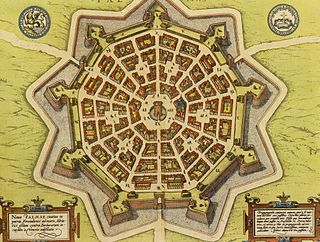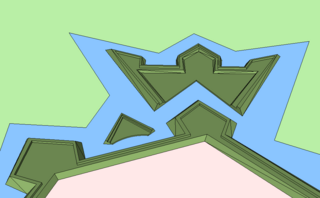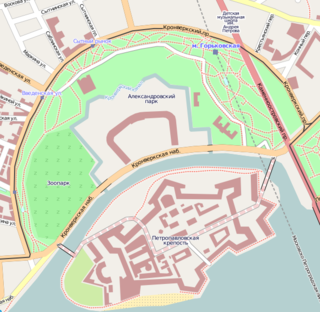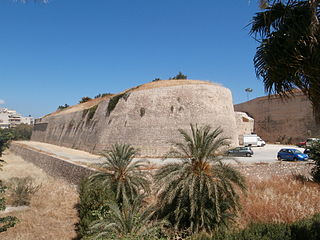



A hornwork is an element of the Italian bastion system of fortification. Its face is flanked with a pair of demi-bastions.
It is distinguished from a crownwork, because crownworks contain full bastions at their centers. They are both outworks.




A hornwork is an element of the Italian bastion system of fortification. Its face is flanked with a pair of demi-bastions.
It is distinguished from a crownwork, because crownworks contain full bastions at their centers. They are both outworks.

Kronborg is a castle and stronghold in the town of Helsingør, Denmark. Immortalized as Elsinore in William Shakespeare's play Hamlet, Kronborg is one of the most important Renaissance castles in Northern Europe and was inscribed on the UNESCO's World Heritage List in 2000.

A bastion or bulwark is a structure projecting outward from the curtain wall of a fortification, most commonly angular in shape and positioned at the corners of the fort. The fully developed bastion consists of two faces and two flanks, with fire from the flanks being able to protect the curtain wall and the adjacent bastions. Compared with the medieval fortified towers they replaced, bastion fortifications offered a greater degree of passive resistance and more scope for ranged defence in the age of gunpowder artillery. As military architecture, the bastion is one element in the style of fortification dominant from the mid 16th to mid 19th centuries.

Nyenschantz was a Swedish fortress at the confluence of the Neva River and Okhta River, the site of present-day Saint Petersburg, Russia. Nyenschantz was built in 1611 to establish Swedish rule in Ingria, which had been annexed from the Tsardom of Russia during the Time of Troubles. The town of Nyen, which formed around Nyenschantz, became a wealthy trading center and a capital of Swedish Ingria during the 17th century. In 1702, Nyenschantz and Nyen were conquered by Russia during the Great Northern War, and the new Russian capital of Saint Petersburg was established by Peter the Great in their place the following year.

Fort Ricasoli is a bastioned fort in Kalkara, Malta, which was built by the Order of Saint John between 1670 and 1698. The fort occupies a promontory known as Gallows' Point and the north shore of Rinella Bay, commanding the entrance to the Grand Harbour along with Fort Saint Elmo. It is not only the largest fort in Malta but also the largest in Europe, and it has been on the tentative list of UNESCO World Heritage Sites since 1998, as part of the Knights' Fortifications around the Harbours of Malta.

A bastion fort or trace italienne is a fortification in a style that evolved during the early modern period of gunpowder when the cannon came to dominate the battlefield. It was first seen in the mid-fifteenth century in Italy. Some types, especially when combined with ravelins and other outworks, resembled the related star fort of the same era.

An outwork is a minor fortification built or established outside the principal fortification limits, detached or semidetached. Outworks such as ravelins, lunettes (demilunes), flèches and caponiers to shield bastions and fortification curtains from direct battery were developed in the 16th century. Later, the increasing scale of warfare and the greater resources available to the besieger accelerated this development, and systems of outworks grew increasingly elaborate and sprawling as a means of slowing the attacker's progress and making it more costly. When taken by an enemy force, their lack of rear-facing ramparts left them totally open to fire from the main works.
Bastion is a fictional supervillain appearing in American comic books published by Marvel Comics. The character was created by Scott Lobdell and Pascual Ferry and first made a cameo appearance in X-Men #52 while his first full appearance was in The Uncanny X-Men #333.

The Halászbástya or Fisherman's Bastion is one of the best known monuments in Budapest, located near the Buda Castle, in the 1st district of Budapest. It is one of the most important tourist attractions due to the unique panorama of Budapest from the Neo-Romanesque lookout terraces. The Fishermen's Bastion's main façade, parallel to the Danube, is approximately 140 meters long, of which the southern aisle is about 40 meters long, the north is 65 meters long, and the ornate central parapet is 35 meters long. Its seven high-pitched stone towers symbolize the seven chieftains of the Hungarians who founded Hungary in 895.

The Floriana Lines are a line of fortifications in Floriana, Malta, which surround the fortifications of Valletta and form the capital city's outer defences. Construction of the lines began in 1636 and they were named after the military engineer who designed them, Pietro Paolo Floriani. The Floriana Lines were modified throughout the course of the 17th and 18th centuries, and they saw use during the French blockade of 1798–1800. Today, the fortifications are still largely intact but rather dilapidated and in need of restoration.

Camp Shorabak is a former British Army airbase, located northwest of the city of Lashkargah in Helmand Province, Afghanistan. The camp was situated in a remote desert area, far from population centres.

The Military Historical Museum of Artillery, Engineers and Signal Corps, also known simply as the Artillery Museum, is a state-owned military museum in Saint Petersburg, Russia. Its collections – consisting of Russian military equipment, uniforms and decorations – are hosted in the Kronverk situated on the right bank of the Neva near Alexander Park. The museum is managed by the Russian Ministry of Defence.

A crownwork is an element of the trace italienne system of fortification and is effectively an expanded hornwork. It consists of a full bastion with the walls on either side ending in half bastions from which longer flank walls run back towards the main fortress.

The Kronverk is a ground fortification for the Sts. Peter and Paul Fortress in Saint Petersburg, Russia. The Kronverk is situated on Petrogradsky Island, across the small island of the fortress proper. It was built in 1705–08, with reconstructions in 1752 and 1800.

Flat Bastion is a bastion which projects southward from the Charles V Wall in the British Overseas Territory of Gibraltar. Once known as the St. Jago's Bastion or the Baluarte de Santiago in Spanish, the fortification was built by the Spanish in the mid 16th century and formed part of the southern defences of the city of Gibraltar, together with Charles V Wall, Southport Gates, Southport Ditch, and South Bastion. In 1859, six guns, four 12-pounders and two 12-pound carronades, were installed on the bastion, and four years later, five 32-pounders were mounted on the fortification.

King's Bastion is a coastal bastion on the western front of the fortifications of the British overseas territory of Gibraltar, protruding from the Line Wall Curtain. It is located between Line Wall Road and Queensway and overlooks the Bay of Gibraltar. It played a crucial role in defending The Rock during the Great Siege of Gibraltar. In more recent history the bastion was converted into a generating station which powered Gibraltar's electricity needs. Today it continues to serve the community as Gibraltar's leisure centre.

The siege of Landau saw an army from the Holy Roman Empire led by Louis William, Margrave of Baden-Baden lay siege to the fortress city of Landau which was held for the Kingdom of France. The French defenders led by Ezéchiel du Mas, Comte de Mélac resisted vigorously but were forced to surrender after a three-month leaguer. This action of the War of the Spanish Succession occurred at Landau in the state of Rhineland-Palatinate, Germany, located 49 kilometres (30 mi) southwest of Mannheim.

The fortifications of Valletta are a series of defensive walls and other fortifications which surround Valletta, the capital city of Malta. The first fortification to be built was Fort Saint Elmo in 1552, but the fortifications of the city proper began to be built in 1566 when it was founded by Grand Master Jean de Valette. Modifications were made throughout the following centuries, with the last major addition being Fort Lascaris which was completed in 1856. Most of the fortifications remain largely intact today.

The fortifications of Heraklion are a series of defensive walls and other fortifications which surround the city of Heraklion in Crete, Greece. The first city walls were built in the Middle Ages, but they were completely rebuilt by the Republic of Venice. The fortifications managed to withstand the second longest siege in history for 21 years, before the city fell to the Ottomans in 1669.

The Fortress of Saint Dmitry of Rostov was a fortification structure of the Russian Empire. In the middle of the 18th century it was of great military and strategic importance and also was the most powerful among the southern fortresses of Russia. The city of Rostov-on-Don was named after the fortress.

The ACMAT Bastion is a modern French armoured personnel carrier, manufactured by ACMAT.